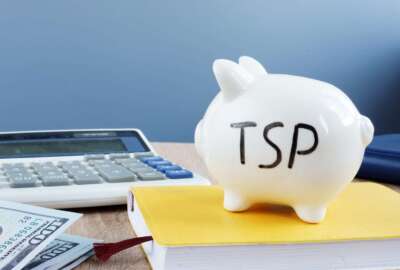In the two weeks or so left of 2024, get the most out of your money
Individuals should take better charge of their own financial lives before the end of the year, including optimizing their Thrift Savings Plan.
The government might be operating on a continuing resolution. Individuals should take better charge of their own financial lives before the end of the year, including optimizing their Thrift Savings Plan. RMG Advisors financial planner Thiago Glieger joined the Federal Drive with Tom Temin to provide some tips.
Interview Transcript:
Tom Temin: And I guess people need to think about required minimum distributions. Everybody knew they would happen some point in life, but then when you really got to make it, you got to be careful about it.
Thiago Glieger: That’s right. The nice thing about the Thrift Savings Plan, the TSP, is that they will actually make sure that the R&D happens for you. But if you’ve got other retirement accounts like old 401(k)s if you worked at a prior career or you have IRAs, you really want to be careful about going into the holiday seasons, getting excited about being with your family. And oops, forgetting to take the required minimum distribution. The IRS has some pretty big penalties for having missed that.
Tom Temin: Right. And what is the age these days? It keeps moving out.
Thiago Glieger: It started at 70 and a half. That’s what most people knew. It bumped to 72, then 73, now 75.
Tom Temin: Yeah. So that means if you can replace, that means you can still keep going by contributing until you have to take the RMDs. If you feel like even if you’re retired and you got some little gig on the side, you can keep throwing it in there till you’re 75.
Thiago Glieger: That’s right. And in fact, if you continue working past 75, you can still contribute to a retirement account. And the nice thing is that the IRS allows you to not have to do RMDs for any 401(k) type accounts, including the TSP that you’re still working and contributing to. So you could be 76, 77. If you’re still working as a federal employee, you actually don’t have RMDs for that account.
Tom Temin: Right. If you are a federal annuitant and maybe you work at Home Depot or something, just for something to do and you like the aprons and you can still put money into a 401(k) beyond the official retirement, then you’re getting your annuity?
Thiago Glieger: Sure you could. It’s not going to go in the TSP because you’re officially an annuitant. But using your example, Home Depot may have a 401(k) that allows you to contribute there. If they don’t, you could also contribute to an IRA. Of course, there’s some income limitations in terms of deductibility and things like that to be aware of.
Tom Temin: Right. They don’t make it easy to grow old even for federal annuitants, do they?
Thiago Glieger: No.
Tom Temin: And what about gifts, charities? That has some effect on all of this, too, in which people tend to think about it this time of year?
Thiago Glieger: That’s exactly right. A lot of conversations with clients involve talking about what kind of charities they may want to donate to this year. And if those are people who also have RMDs, there is a strategy that we often use. It’s called a qualified charitable distribution or for short, it’s QCD, it’s what it’s commonly known as. And the idea is that if you’re going to take money from your retirement account, put it in your bank account and then donate a check to a charity, you pay taxes on the money once it came from the retirement account, unless you’re itemizing, which these days is a very small amount of people, then you’re really not getting the most tax deduction for that. Whereas a QCD allows you to take the money directly from your retirement account and send it straight over to a charity. You don’t pay the taxes, the charity doesn’t pay the taxes, and that counts toward satisfying your R&D. So everyone really wins.
Tom Temin: Right. So if you feel you can live on, say whatever your RMD is and that varies by individual, let’s say it’s 5%, you feel comfortable taking 3% to live on. You could send 2% or whatever to a charity directly and then you would get the tax benefit of not withdrawing that 2% for your own use.
Thiago Glieger: That’s right. And even if you think about smaller donations, maybe some folks don’t have the ability to live on a smaller portion of their retirement accounts. Even if you do $1,000 at year end to a charity. If you think about what your federal and state income tax could be on that, you might be saving $250 on that $1,000, sometimes $300, depending on how much taxes you pay.
Tom Temin: Right. Yeah. If people forget how much real taxes really cost. And then there’s the idea of Roth conversions, where you pay the tax on your withdrawal from your TSP and put it into the after-tax Roth plan. But then of course, you’ve got to pay the tax on it. And that’s not always a clear calculus because you don’t know how long it’s going to take to pay back the tax and etc. So maybe talk about Roth conversions and when they make sense and when they don’t.
Thiago Glieger: Yeah, this is a very popular strategy that the people for whom it benefits is if you are anticipating your tax bracket or just your general adjusted gross income to be higher in the future. So why why might that be? If you’ve accumulated a substantial amount inside your retirement accounts, your required minimum distributions might be substantial. They may be substantial enough that they put you into a higher tax bracket. So if you’re looking out into the future thinking, ‘OK, I have these RMDs coming up. That’s going to put me in another bracket. I might consider taking the taxes right now, paying them through a Roth conversion.’ And the benefit is that there’s no RMDs on the Roth. The Roth gets to grow tax free, so you can consider being more aggressively invested in those types of accounts.
Tom Temin: And the reality is many federal managers in the technology field and specialized fields do retire, not at 65 necessarily, but maybe at 60. They get their FERS annuity and everything else. And they have careers that pay a heck of a lot more than their federal careers did. So people like that should probably really actively consider this idea.
Thiago Glieger: That’s right. Especially if they’re doing a lot of heavy savings. And then they’re going to be stuck with a very short window of time before RMDs. But of course, if you are also earning a really large salary after federal service and that itself is pushing you to a higher bracket, then you have to do some modeling and determine, ‘Hey, what is it really going to cost for me to live after I’ve stopped working in retirement? Is filling my needs and meeting my income requirements. Is that going to be in a lower tax bracket for me based off of what I need compared to what my salary is putting me in today?’ And that’s kind of the juxtaposition that we want to look at which point will owing the taxes be more advantageous? Is it today because I’m in a lower bracket or is it in the future because I’m in a lower bracket?
Tom Temin: It’s your intended or expected bracket that is really the major deciding factor.
Thiago Glieger: That’s right.
Tom Temin: Well, maybe someday we’ll have a flat tax and then it won’t matter so much like corporations. Yeah, we should live so long. We’re speaking with Thiago Glieger . He’s a principal at RMG Advisors of Rockville, Maryland. Capital gains. I think a lot of reasons that small businesses and some of the small businesses that listen, that do federal contracting were worried about unrealized capital gains taxes that were proposed by Sen. Warren and so forth, and I think endorsed by candidate Harris. That won’t likely happen right now, but capital gains, nevertheless, are part of your financial calculus.
Thiago Glieger: That’s right. And for anyone that is holding a taxable mutual fund inside a non-retirement account. So these are your trust accounts, your individual accounts, corporate accounts, joint accounts. You have to consider that the mutual fund companies right around this time of the year, they’re looking to pass on the capital gains that the fund has generated during the year. And this is true even if you don’t sell your investment. This is a common misconception. People think, ‘Well, I didn’t really make any transactions. I didn’t sell the mutual fund, so why would I owe taxes?’ That’s not how the mutual fund works. And so what happens if the markets are really, really strong? As you could see significant capital gains at the end of the year. And the challenge with capital gains is you don’t get to withhold taxes like taxes are withheld from your paycheck or from a retirement account distribution. So in April, when you file your taxes, you might have to have a rather large position of cash to be able to pay these taxes on the capital gains that you now owe.
Tom Temin: Yeah. That could be really a bad bite at the end of the year.
Thiago Glieger: It could. We have seen short-term capital gains, which is taxed just like a salary. That’s the highest form of taxation. We’ve also seen long-term capital gains for clients. And so it’s not unusual to see a few thousand dollars in potential taxes in April.
Tom Temin: All right. And then what is a good donation approach? And also, some people want to give chunks of money to dependents or children or grandchildren at this point of the year to have a tax advantage. But there’s limitations on all of those.
Thiago Glieger: There are. There’s a lot of gifting rules that we need to be aware of. The big thing with providing gifts to charity is that it’s been tough to itemize those because the standard deduction has been so high. So for folks who are regularly donating perhaps smaller amounts, one strategy they could consider is this idea of bunching your donations and you are essentially combining the next maybe five years worth of donations all into one year so that you get to have a larger itemized deduction, actually get the tax credit for that. And then over the next five years, you’re essentially donated yourself out. Donating to kids is also popular. The families that are doing this are typically looking to do the annual gift tax exclusion amount, which is $18,000 per person per recipient. Doing so allows you to stay under the required gift tax exclusion. So you could go in and just donate to children if you are worried about estate taxes or you’re just trying to get money out of your estate.
Tom Temin: And just a note based on the email I got from my alma mater, it said you can combine the benefits of a charitable gift with the security of lifetime income. The school gives you a quarterly payment. It’s called a charitable gift annuity. This seems to be something people are looking for in the sense of that annuity of regular payment they can expect based on whatever they have invested. How do you know whether those are a good idea?
Thiago Glieger: One way to assess whether that’s a good idea is to determine whether you need that liquid pool of cash. Or if you’re OK with just that stream of income. This is the whole should I purchase an annuity or not argument. The stream of cash flow is very nice because it’s kind of like a first pension or social security. You get that guaranteed every single month and that’s really nice for stability of cash flow. But with these kinds of programs, the idea is that upon your death, whatever balance was in that account, that’s no longer going to your family or your heirs that now belongs to the institution, in this case, your alma mater. So in exchange for that, it’s out of your state. So that’s important for some people if they’re looking at estate tax purposes. And during your lifetime, you get the cash flow.
Tom Temin: But it doesn’t transfer like a pension plan, for example. You can choose a distribution such that your remaining spouse after you go gets a portion of your pension. Not possible with this type of thing.
Thiago Glieger: Yeah, there are some variations on different kinds of remainder annuities. However, in most cases, it’s not like a survivor benefit pension where the family keeps earning income and beyond.
Tom Temin: Got it. All right. So then that’s the other calculus you always have to have. Which one of us is going to go first?
Thiago Glieger: That’s right.
Copyright © 2025 Federal News Network. All rights reserved. This website is not intended for users located within the European Economic Area.
Tom Temin is host of the Federal Drive and has been providing insight on federal technology and management issues for more than 30 years.
Follow @tteminWFED






